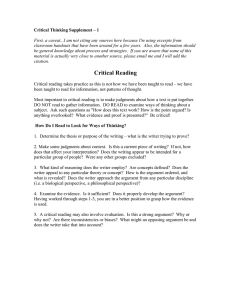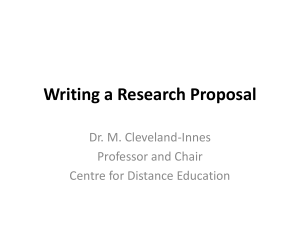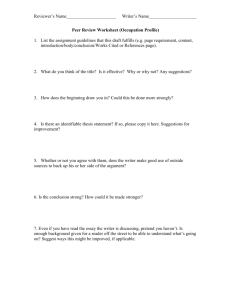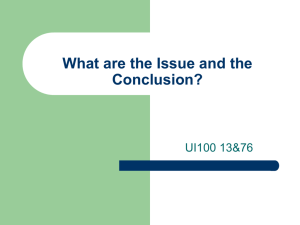Close Reading READING TO WRITE
advertisement
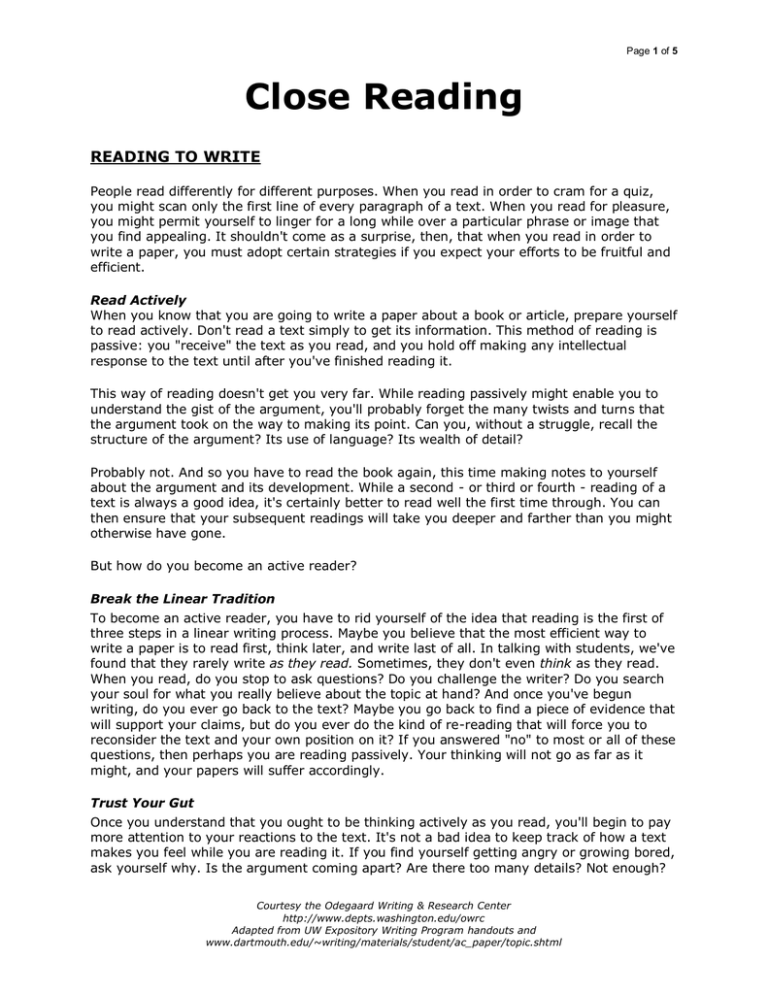
Page 1 of 5 Close Reading READING TO WRITE People read differently for different purposes. When you read in order to cram for a quiz, you might scan only the first line of every paragraph of a text. When you read for pleasure, you might permit yourself to linger for a long while over a particular phrase or image that you find appealing. It shouldn't come as a surprise, then, that when you read in order to write a paper, you must adopt certain strategies if you expect your efforts to be fruitful and efficient. Read Actively When you know that you are going to write a paper about a book or article, prepare yourself to read actively. Don't read a text simply to get its information. This method of reading is passive: you "receive" the text as you read, and you hold off making any intellectual response to the text until after you've finished reading it. This way of reading doesn't get you very far. While reading passively might enable you to understand the gist of the argument, you'll probably forget the many twists and turns that the argument took on the way to making its point. Can you, without a struggle, recall the structure of the argument? Its use of language? Its wealth of detail? Probably not. And so you have to read the book again, this time making notes to yourself about the argument and its development. While a second - or third or fourth - reading of a text is always a good idea, it's certainly better to read well the first time through. You can then ensure that your subsequent readings will take you deeper and farther than you might otherwise have gone. But how do you become an active reader? Break the Linear Tradition To become an active reader, you have to rid yourself of the idea that reading is the first of three steps in a linear writing process. Maybe you believe that the most efficient way to write a paper is to read first, think later, and write last of all. In talking with students, we've found that they rarely write as they read. Sometimes, they don't even think as they read. When you read, do you stop to ask questions? Do you challenge the writer? Do you search your soul for what you really believe about the topic at hand? And once you've begun writing, do you ever go back to the text? Maybe you go back to find a piece of evidence that will support your claims, but do you ever do the kind of re-reading that will force you to reconsider the text and your own position on it? If you answered "no" to most or all of these questions, then perhaps you are reading passively. Your thinking will not go as far as it might, and your papers will suffer accordingly. Trust Your Gut Once you understand that you ought to be thinking actively as you read, you'll begin to pay more attention to your reactions to the text. It's not a bad idea to keep track of how a text makes you feel while you are reading it. If you find yourself getting angry or growing bored, ask yourself why. Is the argument coming apart? Are there too many details? Not enough? Courtesy the Odegaard Writing & Research Center http://www.depts.washington.edu/owrc Adapted from UW Expository Writing Program handouts and www.dartmouth.edu/~writing/materials/student/ac_paper/topic.shtml Page 2 of 5 Is the writer a misogynist? bigot? liberal? conservative? jerk? Pay attention to your own responses. They might be the seeds for your paper. It's possible, too, that you'll find yourself "wowed" by a text. Or that some particular detail, which the author touches on in passing, seems to you to hold the key to a problem that you've been thinking about for a long time. Again, pay attention to yourself as you read. Monitor your reactions. Interrogate them. They might lead you to an interesting paper topic. Enter the Conversation When a writer writes a book she is, in a sense, inviting you into an ongoing conversation. She is taking a position in the great human debate, and she is asking you to take yours. When you write a paper in college, you are entering this conversation. Understand that scholarship is the written exchange of a particular community - in this case, the academic community. As a student, you have joined this community, attending it like you might attend a cocktail party that has the peculiar quality of going on for four years. In essence, what is expected of you as a student isn't far different from what is expected from you as a party-goer. As is true of any party, there are rules that govern your behavior - rules that tell you what you might and might not say, and how you might or might not say it. But the basic rules of conversation are the same in the academy as they are at the cocktail party: you must listen well, you must think on your feet, and you must contribute to the conversation in a way that is relevant, thoughtful, and interesting. In order to enter the conversation fully as a writer, you must first enter the conversation fully as a reader. Pay attention to the text. Take note of how you feel about what the author is saying. Then consider the argument that she is presenting to you. Are there gaps in her argument? Do you want to challenge these gaps? Do you want to fill them in? Do you want to acknowledge the validity of her argument and then apply it to things that she hasn't seemed to consider? All of these questions move you beyond your own reactions to a consideration of the argument. Your conversation with the writer has begun. Use the Margins Maybe the best practical advice we can give you about reading more actively is to make use of the margins. An unmarked book is an unread book. Marking a text as you read it ensures that you are reading actively. Even the simple act of underlining a passage requires you to ask yourself what is most important in a text. The act of weighing importance is one way of breaking the habit of passive reading. But you can do much more in the margins than simply make note of important passages. You can ask questions in the margins. You can draw arrows, establishing obscure connections in the text. You can note patterns of imagery or language as you see them. You can locate contradictions. You can get feisty, even, and call the author out for a debate. You also might find that you can demystify a text by writing in it. After all, reading Socrates or Freud or Marx or Einstein might leave you feeling unsettled, intimidated even. These minds seem so original, so perfect in their way, that it seems impossible at first that your professor is asking you to make some comment on them. Even when you read unknown writers you might feel intimidated. After all, they are published. Their work is deemed good enough to find its way into print. But when you mark your text - when you put your own words on the page right next to the words of Hegel or Hemingway - you discover two Courtesy the Odegaard Writing & Research Center http://www.depts.washington.edu/owrc Adapted from UW Expository Writing Program handouts and www.dartmouth.edu/~writing/materials/student/ac_paper/topic.shtml Page 3 of 5 things. First is that there is "room" for you on the page. Neither Hegel nor Hemingway has the last word on any subject. Second, you come to see that your process is not so much different from theirs. They read texts and they responded to them by writing. Now you are, too. Moving Outside the Text One important idea to understand when you read is that every text has a context. Remember that every writer is in conversation: with other writers, with history, with the forces of her culture, with the events of his time. It is helpful, for example, to read Karl Marx or Sigmund Freud with some knowledge of their moment in history. Virginia Woolf and Simone deBeauvoir were responding to writers and events in their cultures, too. When you understand the context of a work, you can better see the forces that moved the author to write that work. You will gain clarity about what and why the writer was writing. You may even gain clarity about what you yourself would like to say. But how do you place a work in context if you know nothing about the historical time in which it was written? You might take a trip to the library or do some on-line research. Perhaps your professor has reserved some books on the subject. Maybe she has discussed the context of a particular book in class. Even if you know nothing about the context of a particular book or writer, you know a lot about the context of a particular reader: you. You are a member of a complex culture that provides you with a particular context for your reading experience. Your gender, race, and socio-economic class provide context(s) for your understanding of a text. You bring your own context(s) with you when you read texts as diverse as the Declaration of Independence, the Koran, the films of Fellini, and the transcriptions of the Watergate tapes. One word of caution: context needs to be examined with care. Don't assume that the context of your own class or gender or culture is informing you correctly. Read context as actively and as rigorously as you read text! Reading Differently in the Disciplines Each of the different academic disciplines—English, History, Sociology, Psychology, Biology, and so on—asks you to read differently. Sometimes, in fact, they ask you to "read" things that you wouldn't normally consider as "text." For example, in a Sociology class, you might be asked to "read" the behaviors of a particular group of people. In a History class, you might be asked to "read" a sequence of events. In a Geography class, you might be asked to "read" a certain space. You might, in the course of your college career, be asked to "read" a painting, a film, an advertisement, an event, a laboratory experiment, or any number of fascinating things. Before you take on the task of reading any sort of text, you'll want to make sure that you understand the practices of the discipline and the requirements of the assignment. Are you being asked to observe? To argue? To compare? Is there some requirement that you order your observations temporally? Spatially? Logically? What are the conventions for reading, writing, and thinking in this particular discipline? Courtesy the Odegaard Writing & Research Center http://www.depts.washington.edu/owrc Adapted from UW Expository Writing Program handouts and www.dartmouth.edu/~writing/materials/student/ac_paper/topic.shtml Page 4 of 5 SUGGESTED CLOSE READING CHECKLIST As stated above, close reading is a necessary skill that will be very useful to you no matter your discipline or your eventual profession. Your classes, your work, your government, and even your pastimes will require you to read or evaluate something difficult, to find handand footholds in the material, and make sense of it. In general, “close reading” simply means analyzing a text—be it a photograph, a short story, a poem, a scholarly essay, an operation manual, a tax form, a television commercial—very carefully, crystallizing main ideas, and then drawing conclusions or making decisions based on your analysis. In other words, close reading means reading a text closely: looking at the details and discussing how those details lead you to make conclusions about the text. The idea is to look at the little pieces and see how they connect to the whole. Close reading is a writing strategy meant to help you gain a better understanding of your reading of a text and to provide you will the necessary textual evidence to support that reading. The goal of any close reading is the following: an ability to understand the general content of a text even when you don’t understand every word or concept in it. an ability to spot techniques that writers use to get their ideas and feelings across and to explain how they work. an ability to judge whether techniques the writer has used succeed or fail and an ability to compare and contrast the successes and failures of different writers’ techniques. Remember—when doing a close reading, the goal is to closely analyze the material and explain why details are significant. Therefore, close reading does not try to summarize the author’s main points, rather, it focuses on “picking apart” and closely looking at the what the author makes his/her argument, why is it interesting, etc.. The suggested checklist below will help you effectively develop and organize your ideas and produce a close reading. Your approach will vary, depending on if you are just doing a general close reading, or whether you are adapting the instructions below to accommodate an assignment. HOW DO I DO IT? 1. First, gather data. By this, I mean identify the details (the little pieces) that you want to analyze. Keep your focus narrow. Either look at a small section of the text (a few sentences or a paragraph or two) or look at a single repeating detail (a term or stylistic choice that occurs a number of times in different places). If you are choosing to look at a specific detail, then scan back through the text and make sure that you have noticed all the instances in which it takes place. Reread the sections you are working with at least four or five times, so you don’t miss anything. It may help to list the details—the data—on a separate page so you can see clearly what you are working with. Suggestions include: a. Follow the suggestions listed on pages 1-3 of this document. b. Read difficult passages several times. Read them out loud, slowly, deliberately. Difficult parts will be easier the second or third time through. c. Annotate the text. This is sometimes called “active reading.” Annotating involves underlining important words, writing notes or questions in the margins, highlighting, bracketing important passages, taking reading notes, and so on. Courtesy the Odegaard Writing & Research Center http://www.depts.washington.edu/owrc Adapted from UW Expository Writing Program handouts and www.dartmouth.edu/~writing/materials/student/ac_paper/topic.shtml Page 5 of 5 Write down key ideas, pages to return to, terms, and quotes that may be helpful in your own understanding and argument. d. Look up difficult terms or concepts or names and keep a running list. Also try to discover the meaning of key words and concepts from the reading. Some terms have specialized definitions that you will learn only from context. Two good places to look online are: www.dictionary.com and www.wikipedia.com. e. Pay close attention to the rhetorical features of the text, the figures of speech, repetitions, imagery, and word choices. How does the language itself work in the text? f. Consider the historical and cultural context of the text. For whom was it written? By whom? Why? Has it been well received? 2. Next, look for ways that the data is connected. Look for patterns. See if there are parallel structures or ideas. Note the structure of the passage and see if the structure is related to the content in any way. Do you see anything being compared or contrasted? Do these pieces fit together in any meaningful ways? What theme(s) does the work develop? Why is the text or passage or statement important? What are its overall claims? Remember to focus on the “how” and “why”—don’t just summarize what the text does—analyze the text and figure out and explain how the language is down what it’s doing. 3. Finally, report your findings. This is when you communicate the conclusions you have made. You will always need to refer to your data to illustrate, support, and explain your findings. That means paraphrasing or using quotes from the original text. Along with explanations of why those details are important to your discussion. A good rule of thumb is “introduce, quote, explain” when using others’ words in an essay. First, introduce the quote and give it some context, then quote the essential part of the passage, and then explain how that quote ties into your conclusions. Remember, your goal is to show how these small details contribute to the overall meaning of the text. Courtesy the Odegaard Writing & Research Center http://www.depts.washington.edu/owrc Adapted from UW Expository Writing Program handouts and www.dartmouth.edu/~writing/materials/student/ac_paper/topic.shtml

